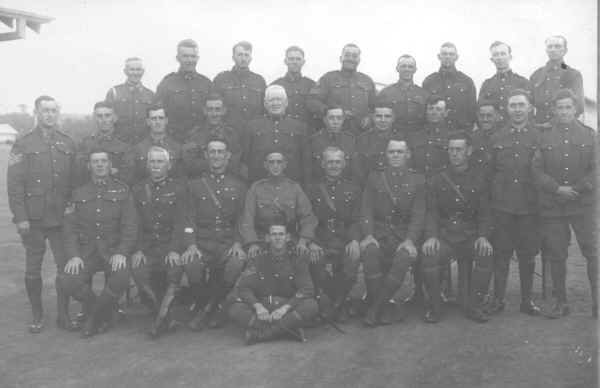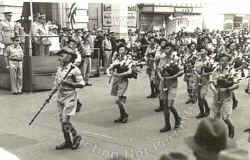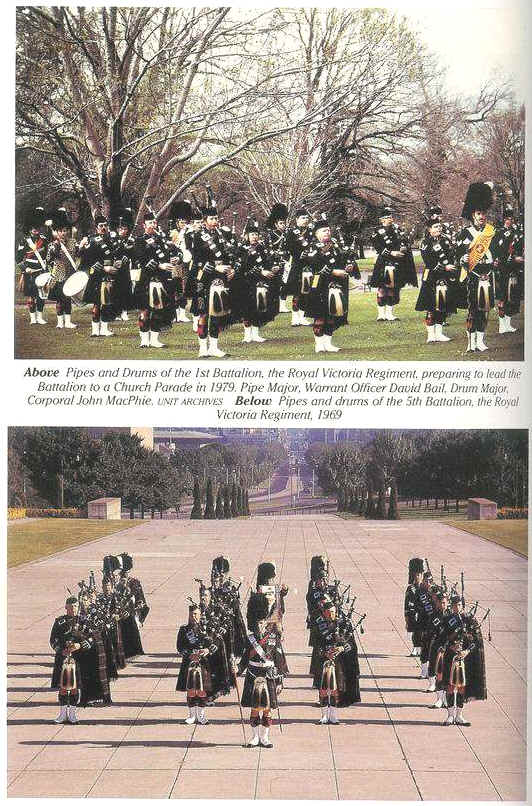|
Early Days
Based on a history document prepared for centenary celebrations
Victorian Military Forces General Order No. 70, dated
3rd September, 1898 read:
Victorian
Scottish Regiment of Volunteers
The
Administrator of the Government in Council has been pleased by order
dated 29th day of August 1898 to approve the formation of a corps of
volunteers to be designated the Victorian Scottish Regiment. (signed)
W. McCulloch, Minister of Defence,
Defence Department, Melbourne.
29 August, 1898
Following
the publication of this authority, the Regiment was formed at Albert
Park by a group of Scottish gentlemen of whom members were Sir John
McIntyre, Sir Malcolm McEachren, Colonel Otter, Richard Linton, W.B.
Jarvie and W.J. McKirdie. Colonel Otter became the first commanding
officer and, after a short term was succeeded by Sir Malcolm McEachren.
A parade ground was made available at Victoria Barracks and here the
majority of parades were held.
At
that time volunteers were issued with rifles, bayonets, haversacks and
water-bottles only and were expected to provide their own uniforms.
Because of this the Regiment paraded in plain
clothes until towards the
end of 1899 when 100 uniforms became available. The cost for officers
was approximately £100 for full dress and the men, £8 (equal to around
$6,000 and $700 or more now).
The
latter dress consisted of white helmet with red and white hackle, khaki
jacket, kilt, sporran, hose tops, Glengarry and trews. They then wore
the Victorian Scottish Regiment tartan, a tartan especially adapted for
the regiment - basically a Gordon tartan with the yellow stripes
replaced by red stripes.)
In
1900 the Band was formed, the purchase of instruments being made
possible by Sir Malcolm McEachren. The strength of the regiment
increased and, when a review took place at Flemington on the opening of
Commonwealth Parliament by the Duke of York (afterwards King George V),
five companies paraded. Each company was over sixty strong, and the
Regiment, now wearing red tunics and led by its two bands, (pipe and
brass), made a fine showing.
 |
Changes
of System
The
Volunteer System was abolished in favour of militia in 1902 and then, in
1911 as a result of some years of investigation, the Commonwealth
Government introduced a system of Universal Training.
This required
service by all able-bodied men between certain ages and voluntary
enlistment was confined to officers and senior non-commissioned
officers.
|
The Militia units formed the nucleus of the new Defence Force.
National dress was abolished and the Victorian Scottish Regiment became
the 52nd Battalion under Colonel D.S. Wanliss, who was later Chief
Justice of New Guinea.
The
1914-18 War
On
the outbreak of the Great War, members of the 51st and 52nd Battalions
combined to form the 5th Battalion A.I.F., under Colonel Wantiss. Many
of the old militia men rejoined and an unsuccessful effort was made to
form a kilted unit. In the formation of the Battalion provision was made
for a Public Schools Company. This was immensely popular, but
unfortunately it was given much of the dangerous work on Gallipoli and
many excellent potential officers were lost.
The
Battalion left Melbourne in October 1914 and after training in Egypt,
took part in the landing at ANZAC, forming part of the force which
attacked Cape Helles. It remained on the Peninsula until the evacuation.
It returned to Egypt in December and shortly after, a portion of the
Battalion was taken to form 57 Battalion. The newly reinforced 5th
completed its training and in March it was sent to France where it took
part in many battles.
Main
engagements were Somme 1916-18, Pozieres, Bullecourt, Ypres 1917, Menin
Road, Polygon Wood, Broodseinde, Poelcapelle, Passchendaele, Lys, Hazebrouck,
Amiens, Albert, Hindenburg Line and Epehy. The Battalion lost
approximately 1,300 killed or died of wounds and won 329 decorations for
gallantry.
Period
after the Great War
When
compulsory training was again commenced in 1919, the 51st and 52nd
Battalions were again formed at Port Melbourne and South Melbourne
respectively, but almost at once the A.I.F. organisation was reinstated
in order to maintain the Great War traditions and the two battalions
were regrouped to form the 2nd/5th Infantry. A further re-grouping of
units in 1921 resulted in portions of other units being added and the
unit became the 5th Battalion.
1925
saw the reintroduction of territorial titles and the 5th was granted the
old title of Victorian Scottish Regiment.
In
November 1929, compulsory training was suspended and Militia training
introduced. The territorial title came into proper use and the lion
rampant badge, together the motto of the old Victorian Scottish
Regiment, Nemo Me Impune Lacessit (No one hurts us with impunity) was
adopted.
 |
|
Members of the Sergeant's Mess at
Seymour 1931. Donor Martina Macey, whose grandfather, Reginald
G.G. Macey is in the photo, 4th from the left, sitting on the bench. |
Immediately,
permission to wear Highland uniform was sought, but owning to the need
for economy, the kilt was not permitted. However, due to the efforts of
the Scottish societies and friends of the Regiment, permission was
eventually obtained and subscriptions, Regimental activities and
individual payments by the men enabled the Regiment, on 6 May 1935 to
again parade in Scottish dress for the first time since 1912.
 |
|
VSR Tug 'o War
Champions, 1930 & 1931 |
| Black ostrich feather
bonnet mounted on a wire frame covered with black cotton.
The bonnet has five black
feather tails on the left side and a white vulture feather plume
on the right side secured by a whitemetal badge of the Victorian
Scottish Regiment mounted on a black silk cockade.
The bonnet band is of black, red
and white diced wool bound around the lower edge with black
velvet.
There is a black silk ribbon
flash at the centre back of the band. The bonnet has a leather
sweat band with two bands of black cotton above it that can be
adjusted by drawstrings to improve the fit on the wearer's head. |
 |

|
Melbourne, Vic. 1 April 1940. Members of
5th Battalion Victorian Scottish Regiment on parade as they return from a three month
training camp.
(Negative by G. Silk) |
1939
- 1945
During
this period, the Victorian Scottish Regiment served in Western Australia
and later in Darwin.
2nd/5th
Inf Bn 2nd AIF. In
1939, soon after the outbreak of war, the Sixth Division was formed for
overseas service. At that time, members of the VSR joined the 2nd/5th
Battalion, which formed part of that division.
| Perth,
WA. 1943-03-18. March through the City of Perth of 5th Australian Infantry
Battalion (Victorian Scottish) and 300 members of the Australian Women's
Army Service in connection with the opening of the Third Liberty Loan.
The salute is being taken by Rear Admiral A.W. Christie, U.S. Navy
(centre figure on dais). The Drum Major is Warrant-officer A. Gilchrist.
Included in the pipers are Private D. McPhie (extreme left), Private K.
Chalmers, Private H P Davidson (second from right, front rank), Private
FO Anderson, Private F W Roberts, Corporal W Featherstone (right, front
rank), Private G Lawson, and Private K L Cameron. |
 |
The
history of the 2/5 Bn tells of the endeavour, courage and sacrifice of
some 2,000 men, who passed through its ranks during the Second World
War. One of the most widely experienced infantry battalions of the 2nd
AIF, it sailed from Australia in April 1940 and saw service in Libya,
Greece, Crete, Syria, Ceylon and New Guinea. It's members won many
decorations for bravery.
1948
- 1960
June
1948 saw the regiment raised again, commanded by Lt Col G.R. James
Warfe, DSO, MC, ED, with its regimental HQ at Hawthorne and depots at
Dandenong, Kew, Armadale and Surrey Hills. It was during the 1948-1960
period that the regiment played a vital part in the training of many
hundreds of National Servicemen. In 1960, the Regiment disbanded and its
members absorbed into the newly formed Royal Victoria Regiment, forming
initially two Scottish companies. The
5th Bn being the former Victorian Scottish Regiment and the 6th Bn being
the Royal Melbourne Regiment.
 |
Post
1960
The
Regiment was raised again as a Scottish Unit in May 1965 as the
5th Bn The Royal Victoria Regiment (RVR). Early in the 1970s, the
5th Bn was briefly absorbed into 1st RVR, with only the Pipes and
Drums to carry on the spirit of the Victorian Scottish Regiment. A
further re-organisation resulted in 5th/6th Bn, RVR, with 5th and
6th Bn being recognised (also at that time 8/7 Bn RVR was formed
in country Victoria.)
B Company of 5/6RVR continues the
tradition of the Victorian Scottish Regiment and has in the past been
kilted. However, lack of government support and declining community
interest has led to limited elements of the Unit appearing in kilts,
again leaving the Pipes and Drums to carry on the traditions of the
Victorian Scottish Regiment. With the formation of the RVR, all previous
badges were replaced by the RVR hat badge.
|
|

|
|
Pipes & Drums
of 5th Battalion Royal Victoria Regiment, 1969 |
Current
From
time to time various members of the regiment parade in Gordon kilt and
balmorals. For example, on ANZAC Day the RSM and Adjutant have been
kilted.
The
band continues to perform in Gordon kilt and plaid, although the RVR hat
badge, collar dogs and shoulder titles are worn. Associate members of
the pipes and drums wear the VSR badge when competing in highland
competitions. All Victoria Scottish Regiment uniform items, such as
kilts, plaids, badges and other highland dress are supplied through tax
free donations to the RVR Pipes and Drums Association
Incorporated.
Thus,
the tradition continues - in the face of many obstacles - through the
personal determination of the Pipes and Drums and the kind financial
support of friends of the VSR. In other words, the only reason the band
appears at all is due to financial donations and devotion of a great
deal of time. Thank you especially to the committee members of the
Association, who administer the fund raising and distribution. http://www.geocities.com/lionelboxer/rvrpd/history.html
|